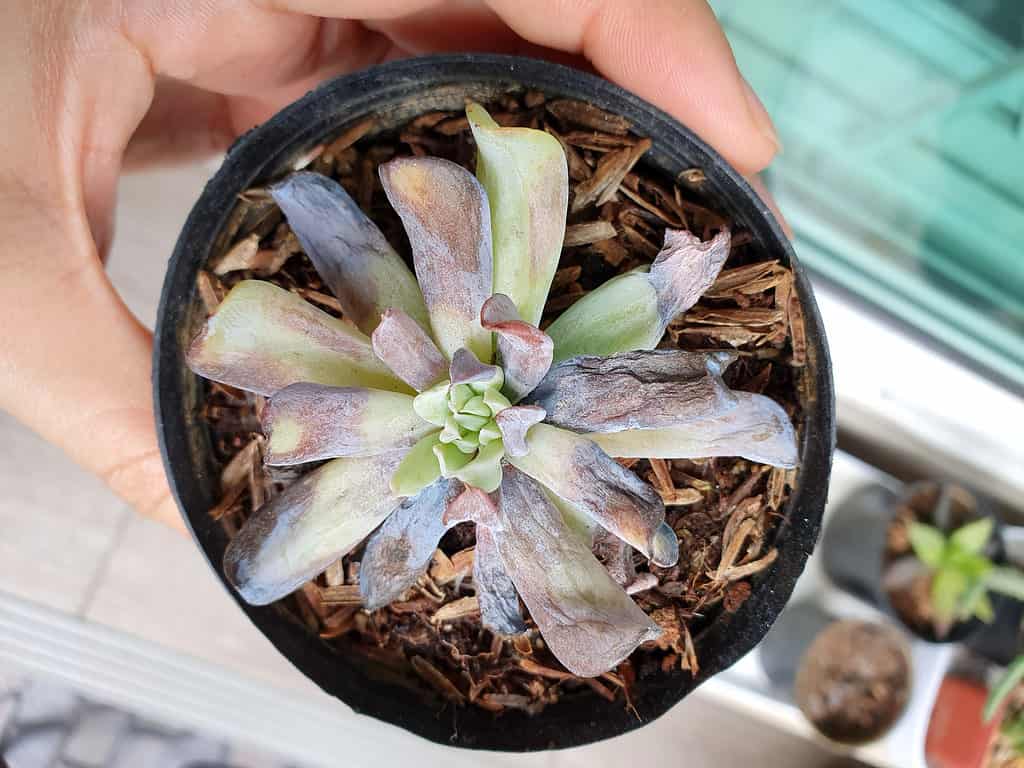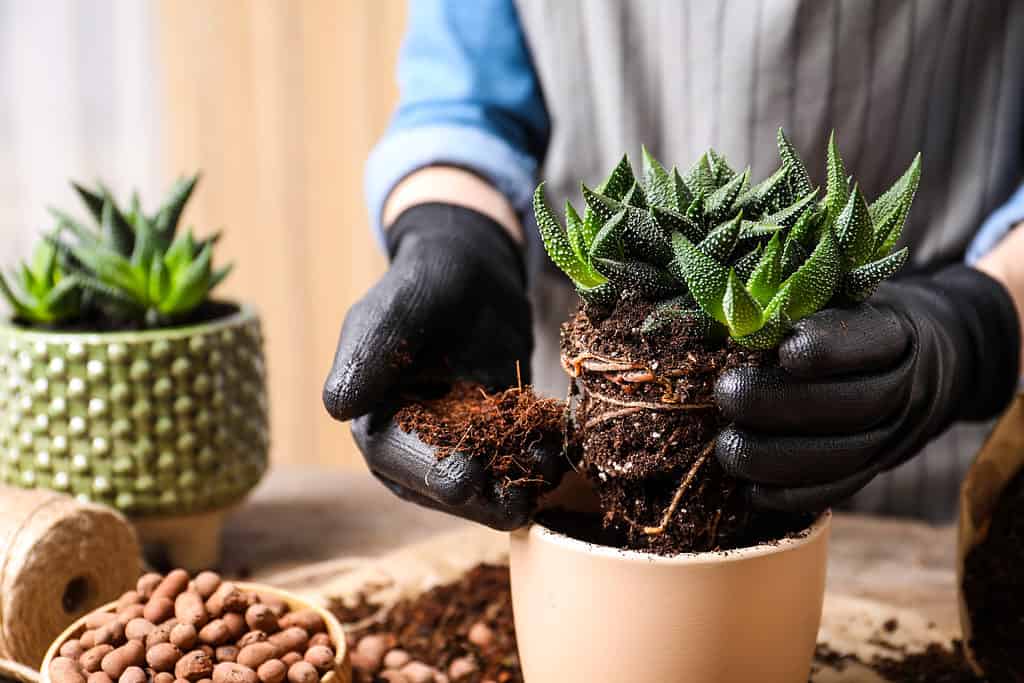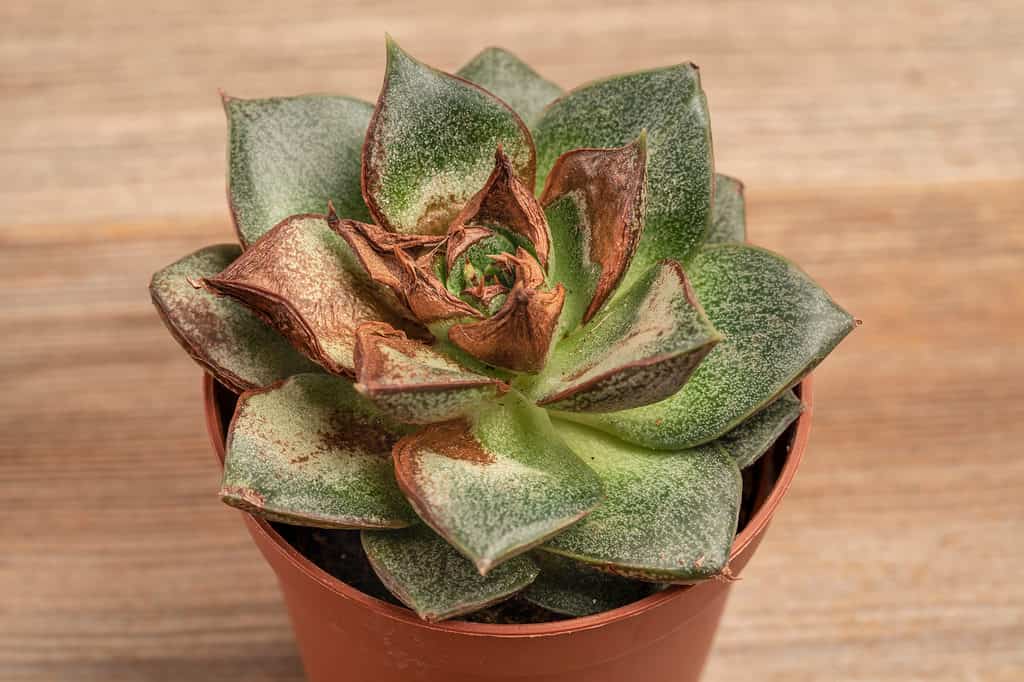There’s nothing worse than realizing that one of your beloved plants is struggling. While succulents tend to be resilient and easy to care for, there are several issues that can have a negative — even fatal — impact.
This article outlines the common problems that impact succulents and, more importantly, how to save them.
Overwatering
One of the most common issues that impact succulents is overwatering. New succulent owners will often follow a set schedule for watering their succulents, which isn’t always conducive to their growth. When problems start to arise, the first concern is whether the plant has enough water. This confusion leads to new succulent owners adding more water and worsening the issue.
When overwatered, your succulent’s leaves may turn slightly yellow or become mushy and heavy.
How to Save a Succulent from Overwatering
Most succulents only need to be watered every two to three weeks. Waiting for the top inch of soil to dry completely between watering is best practice, as it also allows for seasonal fluctuations.
If you believe your succulent has been overwatered, remove the entire plant from the soil (discard all of the dirt) and let it dry completely. Don’t place it in direct sunlight, as this can burn the tender roots. Look at the stem and roots for signs of discoloration and rot, trimming away affected tissue.
Repot the plant in fresh, well-draining soil and let it rest. You may also decide to take a few cuttings just in case the parent plant can’t recover.
Underwatering
While succulents are desert plants known for their drought resistance, it is possible to underwater them too.
If your succulent is underwatered, its leaves may wither, shrivel, and become discolored. Some succulents will also change color, becoming duller and less vibrant. Your succulent may droop or show minimal signs of growth over time.

If your succulent is underwatered, its leaves may wither, shrivel, and become discolored.
©Mintapich/Shutterstock.com
How to Save a Succulent from Underwatering
Saving a succulent from underwatering is easy: just water it. Give your plant a good soak, letting the water soak in and gradually adding more until it runs through the drainage holes.
Many new succulent owners confuse the risk of root rot with hydrophobia. It’s not the excess of water that will kill your plant; it’s if the roots are left sitting in the moisture.
Poor Soil Drainage
Overwatering and underwatering can both be a symptom of poor soil drainage. The soil may lack sufficient drainage for the plant, leading to root rot. Alternatively, it may have too much drainage, which limits your succulent’s ability to absorb the water before it flows out.
How to Save a Succulent from Poor Soil Drainage
If you notice the water draining quickly, but know you have a good cactus or succulent mix, consider your repotting schedule. Succulents should be repotted at least every two years with fresh soil to reintroduce nutrients. The soil you once used may no longer be healthy for your succulent.
Repot your struggling succulent in a succulent mix, or blend your own with a mix of potting soil, sand, and perlite.

Succulents should be repotted at least every two years with fresh soil to reintroduce nutrients.
©New Africa/Shutterstock.com
Insufficient Lighting
Succulents love their sunshine, preferring six or more hours per day. Insufficient lighting is a common issue succulent owners face, especially during the winter months.
Legginess is one of the most common signs that a succulent isn’t getting enough sun. This is when the rosette becomes less compact to allow more surface area to come in contact with the sun — a response commonly referred to as stretching.
Slow growth and discoloration can also indicate poor lighting. It’s important to look at the bigger picture to determine whether the issue is soil drainage, lighting, or both.
How to Save a Succulent from Insufficient Lighting
First, consider the placement of your succulent. It should have access to bright, indirect sunlight for most of the day. Consider putting it near a South or East-facing window.
An LED or fluorescent glow light for your succulents will help them get enough sun if your home’s layout prevents it or to survive the winter months.

If a succulent is stretching itself towards the light that is a common sign that the plant isn’t getting enough sun.
©Agnieszka Pas/Shutterstock.com
Too Much Sunlight
As the saying goes, too much of a good thing isn’t a good thing at all. While succulents love the sun, they can also get shocked or burnt from too much of it.
Many of the symptoms of a sunburned succulent are similar to that of an overwatered succulent. The leaves may become discolored, mushy, or wilted. They may also develop white, brown, or black patches that dry out over time.
How to Save a Succulent from Too Much Sunlight
Prevention is key when saving a succulent from getting too much sun. Many succulent owners are eager to return their plants to sunlight after the winter. Avoid placing it in direct sun, and use a gradual exposure plan over a couple of weeks. Place the plant in a sunny spot for 1-2 hours each day, then slowly increase the exposure time.
If your succulent has white or brown patches, move it to a shaded area for a week and give it a good soak (if the soil is completely dry). Monitor the plant and ensure the markings are gone or dried out before gently reintroducing it to indirect sunlight.
If your succulent is brown and wilted, it may be past saving. Follow the same approach as above, keeping the plant in a shady area and nourishing the roots. Cut back the plant to remove the dead tissue and redirect energy to the root system. It may take months for your succulent to recover. Just keep caring for it and test the roots by gently tugging, watching for signs of new growth.

If your succulent has had too much sun it may become discolored, or wilted with white, brown, or black patches that dry out over time.
©Berna Namoglu/Shutterstock.com
Cold Shock
Cold shock can present in several ways, depending on the severity of the damage. If your succulent gets slightly cold, it may drop a few leaves. If the damage is severe, it could blacken and wilt entirely.
One of the challenges with identifying cold damage is that it can take days or weeks to show. This is an issue if the plant is located somewhere near a draft or unsuspecting cold spot.
How to Save a Succulent from Cold Shock
First, move the succulent to a warmer area and make sure it’s not near any drafts or vents. Place it in indirect sunlight and watch for signs of wilting and damage.
If the plant begins to wilt, cut away the dead leaves to redirect energy and nutrients. If the succulent is still struggling, inspect the roots for signs of damage. The root ball should be compact and lively. Trim away loose, dead pieces and repot your succulent in fresh soil.
Pest Infections
Succulents are prone to pest infections. The three main culprits tend to be:
- Spider mites – these are tiny and difficult to spot, but their webs will be visible.
- Mealybugs – these small, furry pests are white to red in color and often cluster together close to the stem.
- Scale insects – these are brown to white with hard shells and can typically be found on the stem or leaves.
Inspect your succulents frequently for signs of pest invasions. If your succulents are yellowing or starting to wilt, pests could be draining their nutrients.
How to Save Succulents from Pests
First, isolate the affected plants to prevent spread. Use a cotton swab with warm water and dish soap to gently wipe down the leaves of your succulent, physically removing the pests. If the issue persists, use a succulent-friendly pesticide solution.
Fungal Infections
Fungal infections are common in succulents growing in overly crowded or humid planters. One of the most common fungal infections is mildew growth, which presents as a white powder-like substance. Botrytis is also common and is identifiable by its gray or brown fuzzy growth.
How to Save Succulents from Fungal Infections
Ensuring your succulents have room to breathe is an important preventative measure. Isolate the affected plant, sterilize your hands and tools, and trim away the affected parts. Overwatering can also lead to fungal growth, so let the soil dry completely between soaks.
If the fungus can’t be cut away, look for a succulent-safe fungicide.

One of the most common fungal infections is mildew growth, which presents as a white powder-like substance.
©Krichevtseva/Shutterstock.com
Bacterial Infections
Bacterial infections are another common concern for succulents and are typically caused by overwatering. Your succulent may be battling bacteria if the leaves become mushy or you notice brown or black spots.
How to Save Succulents from Bacterial Infections
Isolate the succulent from other plants. Then, remove the succulent from its pot and gently wash away any remaining dirt. Trim away the affected areas.
If you’re reusing the same pot, wash it well with hot water and soap to eliminate any remaining bacteria. Replant your succulent in fresh soil.
The photo featured at the top of this post is © Adriana Marteva/Shutterstock.com
Thank you for reading! Have some feedback for us? Contact the AZ Animals editorial team.






